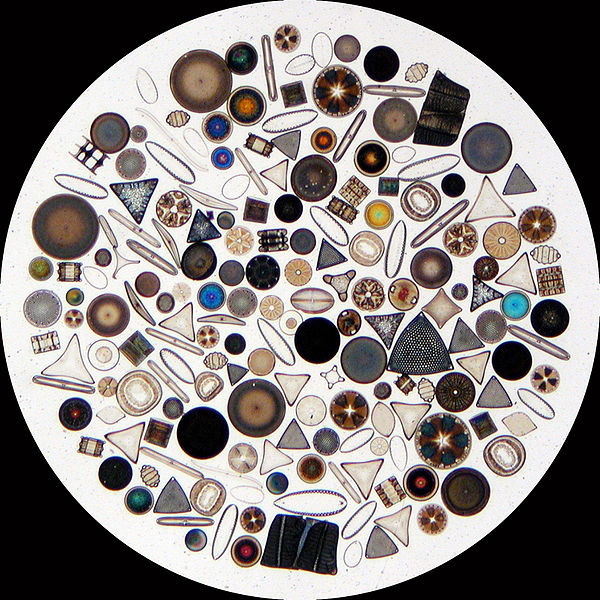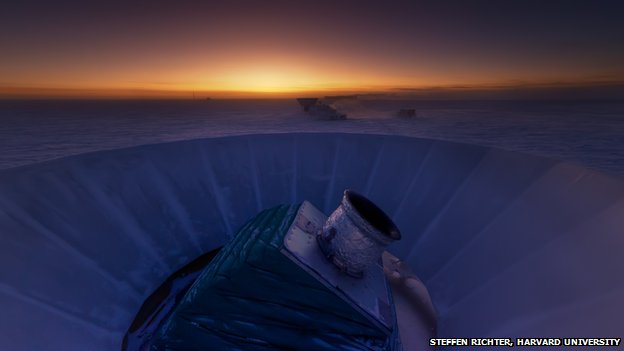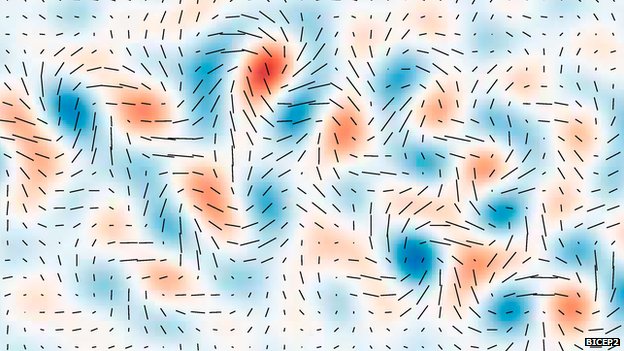Can We Know the Universe? Reflections on a Grain of Salt
by Carl Sagan
The following excerpt was published in Broca's Brain (1979)
"Nothing is rich but the inexhaustible wealth of nature. She shows us only surfaces, but
she is a million fathoms deep." — Ralph Waldo Emerson
Science is a way of thinking much more than it is a body of knowledge. Its goal is to find out how the world works, to seek what regularities there may be, to penetrate the connections of things—from subnuclear particles, which may be the constituents of all matter, to living organisms, the human social community, and thence to the cosmos as a whole. Our intuition is by no means an infallible guide. Our perceptions may be distorted by training and prejudice or merely because of the limitations of our sense organs, which, of course, perceive directly but a small fraction of the phenomena of the world. Even so straightforward a question as whether in the absence of friction a pound of lead falls faster than a gram of fluff was answered incorrectly by Aristotle and almost everyone else before the time of Galileo. Science is based on experiment, on a willingness to challenge old dogma, on an openness to see the universe as it really is. Accordingly, science sometimes requires courage—at the very least the courage to question the conventional wisdom.
Beyond this the main trick of science is to really think of something: the shape of clouds and their occasional sharp bottom edges at the same altitude everywhere in the sky; the formation of the dewdrop on a leaf; the origin of a name or a word—Shakespeare, say, or "philanthropic"; the reason for human social customs—the incest taboo, for example; how it is that a lens in sunlight can make paper burn; how a "walking stick" got to look so much like a twig; why the Moon seems to follow us as we walk; what prevents us from digging a hole down to the center of the Earth; what the definition is of "down" on a spherical Earth; how it is possible for the body to convert yesterday's lunch into today's muscle and sinew; or how far is up—does the universe go on forever, or if it does not, is there any meaning to the question of what lies on the other side? Some of these questions are pretty easy. Others, especially the last, are mysteries to which no one even today knows the answer. They are natural questions to ask. Every culture has posed such questions in one way or another. Almost always the proposed answers are in the nature of "Just So Stories," attempted explanations divorced from
experiment, or even from careful comparative observations.
But the scientific cast of mind examines the world critically as if many alternative worlds might exist, as if other things might be here which are not. Then we are forced to ask why what we see is present and not something else. Why are the Sun and the Moon and the planets spheres? Why not pyramids, or cubes, or dodecahedra? Why not irregular, jumbly shapes? Why so symmetrical worlds? If you spend any time spinning hypotheses, checking to see whether they make sense, whether they conform to what else we know, thinking of tests you can pose to substantiate or deflate your hypotheses, you will find yourself doing science. And as you come to practice this habit of thought more and more you will get better and better at it. To penetrate into the heart of the thing—even a little thing, a blade of grass, as Walt Whitman said—is to experience a kind of exhilaration that, it may be, only human beings of all the beings on this planet can feel. We are an intelligent species and the use of our intelligence quite properly gives us pleasure. In this respect the brain is like a muscle. When we think well, we feel good. Understanding is a kind of ecstasy.
But to what extent can we really know the universe around us? Sometimes this question is posed by people who hope the answer will be in the negative, who are fearful of a universe in which everything might one day be known. And sometimes we hear pronouncements from scientists who confidently state that everything worth knowing will soon be known—or even is already known—and who paint pictures of a Dionysian or Polynesian age in which the zest for intellectual discovery has withered, to be replaced by a kind of subdued languor, the lotus eaters drinking fermented coconut milk or some other mild hallucinogen. In addition to maligning both the Polynesians, who were intrepid explorers (and whose brief respite in paradise is now sadly ending), as well as the inducements to intellectual discovery provided by some hallucinogens, this contention turns out to be trivially mistaken.
Let us approach a much more modest question: not whether we can know the universe or the Milky Way Galaxy or a star or a world. Can we know, ultimately and in detail, a grain of salt? Consider one microgram of table salt, a speck just barely large enough for someone with keen eyesight to make out without a microscope. In that grain of salt there are about 1016 sodium and chlorine atoms. That is a 1 followed by 16 zeros, 10 million billion atoms. If we wish to know a grain of salt we must know at least the three-dimensional positions of each of these atoms. (In fact, there is much more to be known—for example, the nature of the forces between the atoms—but we are making only a modest calculation.) Now, is this number more or less than a number of things which the brain can know?
How much can the brain know? There are perhaps 1011 neurons in the brain, the circuit elements and switches that are responsible in their electrical and chemical activity for the functioning of our minds. A typical brain neuron has perhaps a thousand little wires, called dendrites, which connect it with its fellows. If, as seems likely, every bit of information in the brain corresponds to one of these connections, the total number of things knowable by the brain is no more than 1014, one hundred trillion. But this number is only one percent of the number of atoms in our speck of salt.
So in this sense the universe is intractable, astonishingly immune to any human attempt at full knowledge. We cannot on this level understand a grain of salt, much less the universe. But let us look a little more deeply at our microgram of salt. Salt happens to be a crystal in which, except for defects in the structure of the crystal lattice, the position of every sodium and chlorine atom is predetermined. If we could shrink ourselves into this crystalline world, we would rank upon rank of atoms in an ordered array, a regularly alternating structure—sodium, chlorine, sodium, chlorine, specifying the sheet of atoms we are standing on and all the sheets above us and below us. An absolutely pure crystal of salt could have the position of every atom specified by something like 10 bits of information. This would not strain the information-carrying capacity of the brain.
If the universe had natural laws that governed its behavior to the same degree of regularity that determines a crystal of salt, then, of course, the universe would be knowable. Even if there were many such laws, each of considerable complexity, human beings might have the capability to understand them all. Even if such knowledge exceeded the information-carrying capacity of the brain, we might store the additional information outside our bodies—in books, for example, or in computer memories—and still, in some sense, know the universe.
Human beings are, understandably, highly motivated to find regularities, natural laws. The search for rules, the only possible way to understand such a vast and complex universe, is called science. The universe forces those who live in it to understand it. Those creatures who find everyday experience a muddled jumble of events with no predictability, no regularity, are in grave peril. The universe belongs to those who, at least to some degree, have figured it out.It is an astonishing fact there are laws of nature, rules that summarize conveniently—not just qualitatively but quantitatively—how the world works. We might imagine a universe in which here are no such laws, in which the 1080 elementary particles that make up a universe like our own behave with utter and uncompromising abandon. To understand such a universe we would need a brain at least as massive as the universe. It seems unlikely that such a universe couldhave life and intelligence, because beings and brains require some degree of internal stability and order. But even if in a much more random universe there were such beings with an intelligence much greater than our own, there could not be much knowledge, passion or
joy.
Fortunately for us, we live in a universe that has at least important parts that are knowable. Our common-sense experience and our evolutionary history have prepared us to understand something of the workaday world. When we go into other realms, however, common sense and ordinary intuition turn out to be highly unreliable guides. It is stunning that as we go close to the speed of light our mass increases indefinitely, we shrink towards zero thickness in the direction of motion, and time for us comes as near to stopping as we would like. Many people think that this is silly, and every week or two I get a letter from someone who complains to me about it. But it is a virtually certain consequence not just of experiment but also of Albert Einstein's brilliant analysis of space and time called the Special Theory of Relativity. It does not matter that these effects seem unreasonable to us. We are not in the habit of traveling close to the speed of light. The testimony of our common sense is suspect at high velocities.
Or consider an isolated molecule composed of two atoms shaped something like a dumbbell—a molecule of salt, it might be. Such a molecule rotates about an axis through the line connecting the two atoms. But in the world of quantum mechanics, the realm of the very
small, not all orientations of our dumbbell molecule are possible. It might be that the molecule could be oriented in a horizontal position, say, or in a vertical position, but not at many angles in between. Some rotational positions are forbidden. Forbidden by what? By the laws of nature. The universe is built in such a way as to limit, or quantise, rotation. We do not experience this directly in everyday life; we would find it startling as well as awkward in sitting-up exercises, to find arms out stretched from the sides or pointed up to the skies permitted but many intermediate positions forbidden. We do not live in the world of the small, on the scale of 10-13 centimeters, in the realm where there are twelve zeros between the decimal place and the one. Our common-sense intuitions do not count. What does count is experiment—in this case observations from the far infrared spectra of molecules. They show molecular rotation to be quantized.
The idea that the world places restrictions on what humans might do is frustrating. Why shouldn't we be able to have intermediate rotational positions? Why can't we travel faster than the speed of light? But so far as we can tell, this is the way the universe is constructed. Such prohibitions not only press us toward a little humility; they also make the world more knowable. Every restriction corresponds to a law of nature, a regulation of the universe. The more restrictions there are on what matter and energy can do, the more knowledge human beings can attain. Whether in some sense the universe is ultimately knowable depends not only on how many natural laws there are that encompass widely divergent phenomena, but also on whether we have the openness and the intellectual capacity to understand such laws. Our formulations of the regularities of nature are surely dependent on how the brain is built,
but also, and to a significant degree, on how the universe is built.
For myself, I like a universe that includes much that is unknown and, at the same time, much that is knowable. A universe in which everything is known would be static and dull, as boring as the heaven of some weak-minded theologians. A universe that is unknowable is no fit place for a thinking being. The ideal universe for us is one very much like the universe we inhabit. And I would guess that this is not really much of a coincidence.
( Carl Sagan, "Can We Know the Universe?: Reflections on a Grain of Salt;" from Broca's Brain: Reflections on the Romance of
Science, New York: Random House, 1979, pp. 13-18. )











